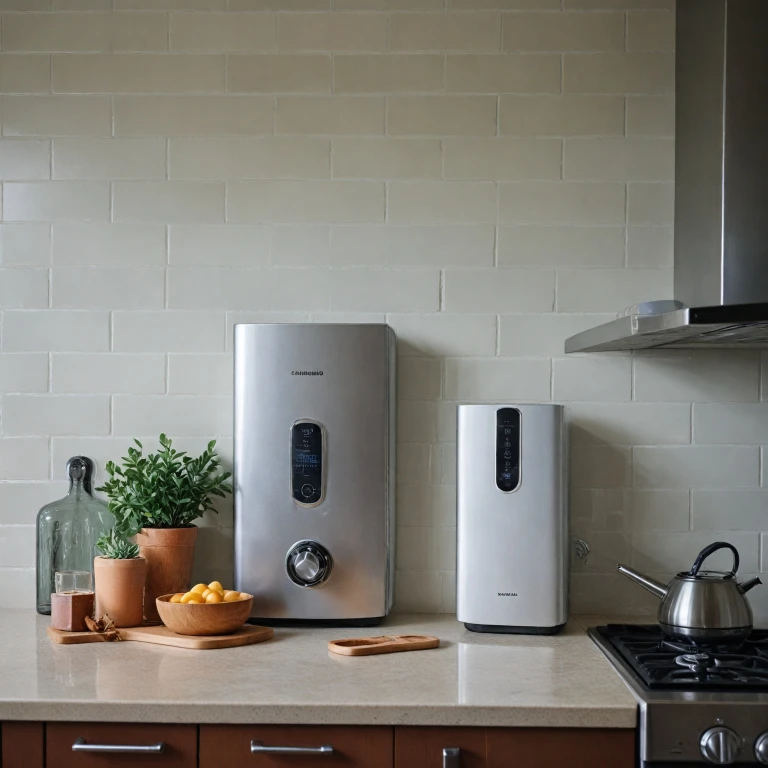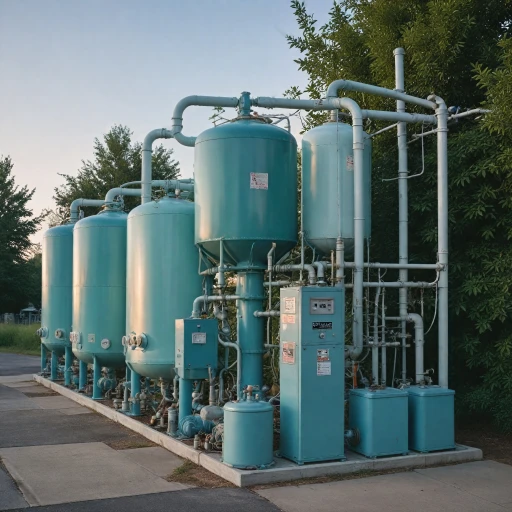Understanding Smart Thermostats for Hot Water Heaters
Integrating Technology with Hot Water Heaters
For those venturing into the domain of smart home technology, understanding the functionality and advantages of a smart thermostat for hot water heaters can be enlightening. Similar to integrating smart technology with regular home thermostats, water heater thermostats cater specifically to the hot water system in your home, offering improved efficiency and control. The core of this advancement lies in the ability to regulate the temperature with precision. Users can manage both the upper and lower thermostats of an electric water heater, ensuring that the upper and lower elements heat optimally. This not only maintains consistent hot water availability but also prevents energy wastage often associated with traditional thermostats.Types and Compatibility Considerations
Before diving into the choices available, it’s crucial to identify the type of water heater currently in use – whether a Rheem, Camco, or otherwise. Compatibility will differ between tank-based, electric, and gas heaters. Electric water heater thermostats typically involve upper and lower thermostat control, while gas water heaters might require adjustments to the gas control valve or gas thermostats. Smart thermostats are also adaptable and can range from single element to double element systems. Popular brands accessible on platforms like Amazon include various features, often supporting remote control and scheduling, which simplifies temperature adjustments according to your preferences. For the best choice, consider factors like the temperature range supported, ease of installation, and compatibility with your existing home automation systems. Additionally, evaluating the price among different smart thermostats would help in making an economical choice without compromising on quality or efficiency. For more detailed insights on the advantageous aspects of smart thermostats, explore an informative guide here for a deeper understanding. Through such resources, consumers can gain a comprehensive grasp of effective implementation and energy savings.Benefits of a Smart Hot Water Heater Thermostat
Advantages of Incorporating Smart Technology
In the realm of home automation, a smart hot water heater thermostat offers numerous advantages beyond conventional thermostats. Opting for smart technology doesn't just mean modernizing your home's aesthetic; it transforms the way you interact with systems that rely heavily on energy, like water heaters. Having a smart thermostat for your water heater means precise control over your water temperature settings. Whether you rely on an electric water heater with dual elements like upper and lower thermostats or prefer gas control through a gas valve, these intelligent systems can streamline operations.Energy Efficiency and Monitoring Capabilities
One of the primary benefits of a smart thermostat is its ability to enhance energy efficiency. Intelligent water heater systems like those from Rheem or Camco can learn your household's hot water usage patterns and adjust the heat elements accordingly. By managing how and when these elements, whether electric or gas, work, you can ensure you're only using the energy you need, thereby potentially lowering electric bills. Furthermore, smart thermostats for water heaters also offer remote monitoring capabilities. Through mobile apps and platforms from retailers like Amazon, users can manage their settings from anywhere, providing flexibility and peace of mind. Imagine being able to adjust your heater thermostat settings from your phone before you return home or turning off your hot water supply if you've departed suddenly.Tailored Comfort and Safety
Smart thermostats can provide customized comfort by ensuring your water heater maintains the desired temperature. Whether you're dealing with a single element system, a tank, or using a therm disc for precise control, these devices ensure that your hot water is always at the ready, tailored to your personal preference without the constant need to manually adjust the controls. Additionally, safety enhancements are a notable advantage. Risks associated with gas water heaters, such as potential malfunctions in the upper or lower thermostat, can be mitigated by smarter diagnostic tools. These tools can quickly identify issues in water heater parts, reducing maintenance costs over time. For those interested in deeper insights regarding the advantages of deploying such smart systems, a detailed exploration is available on understanding the benefits of smart thermostats. This deeper understanding emphasizes how these devices can elevate everyday living by providing better control and optimizing energy use.Challenges in Implementing Smart Thermostats
Addressing Potential Hurdles with Smart Thermostats
Implementing smart thermostats for your water heater brings about a series of considerations that can be daunting yet manageable. As with any technology, challenges may arise, especially when integrating new systems with existing setups.
Many homeowners encounter difficulties when replacing traditional thermostat systems with smart options, particularly regarding compatibility with electric or gas water heaters. When dealing with single element or dual-element electric water heaters, both the upper thermostat and lower thermostat need attention to ensure harmonious function. Ensuring that the new smart thermostat works seamlessly with your current heater thermostats—whether Rheem, Camco, or other brands—is crucial.
The installation process can also present challenges. While some smart thermostat models promise easy DIY installations, others may require professional intervention, especially in systems with complex configurations including upper and lower elements, or gas controls such as gas valves and therm discs. Missteps during installation could affect the thermostat’s ability to properly regulate the tank's temperature, potentially resulting in inefficiencies.
Connectivity is another hurdle to consider. Smart thermostats rely on internet connectivity to maximize their functionality. In homes with unstable or weak internet connections, features like remote monitoring and control may be compromised. Moreover, addressing the initial price investment can be perplexing, as the cost of smart thermostats—available on platforms like Amazon—differs significantly based on features and compatibility.
For those transitioning from traditional to smart thermostats, guidance is available to navigate these complexities. By referring to detailed guides such as navigating the Robertshaw thermostat guide, users can better understand installation prerequisites and troubleshoot common issues. Thus, practical understanding and preparation are key to overcoming the typical challenges associated with smart thermostat implementation, ultimately enhancing your home heating system's efficiency.
Energy Efficiency and Cost Savings
Achieving Energy Savings and Reduced Costs
Smart thermostats for hot water heaters are designed to optimize energy efficiency, which can significantly lower your utility bills. By using advanced technology, these units ensure that the heater operates within an optimal range, preventing unnecessary waste. Here's how they help in achieving energy savings:- Precision Control: With a smart thermostat, you gain control over both the upper and lower thermostats of your water heater. This ability to adjust settings for the upper thermostat and the thermostat lower helps in maintaining the desired water temperature without overuse of energy.
- Adaptive Technology: Many smart thermostats, including models used for electric water heaters, adapt to your heating patterns. They learn from your usage and adjust the heating cycles accordingly, ensuring that the heater only runs when it's likely to be needed.
- Efficient Heating Elements: The integration of smart elements, such as a single element or dual elements in electric water heaters, allows for more efficient heating. These elements ensure a uniform temperature distribution in the water tank, reducing the strain on the heater parts and improving overall energy consumption.
- Scheduled Heating: Some advanced models enable you to schedule when your heater turns on and off. This feature is especially useful for gas heaters equipped with a gas control or gas valve, as it allows precise control over heating times, thereby conserving energy during off-peak times.
Choosing the Right Smart Thermostat for Your Needs
Key Considerations for Selecting Your Smart Thermostat
When it comes to outfitting your water heaters with smart thermostats, you must carefully assess various factors to ensure you select a suitable model. Here's a breakdown of what to consider:- Compatibility: Not all smart thermostats are compatible with every type of water heater. Consider if your heater is gas, electric water, or if it has specific elements like single element or upper lower thermostats. Rheem and other major brands might offer compatible models, but it's essential to verify against your heater type.
- Control Features: Look for thermostats that offer precise control over your heater’s temperature. A good smart thermostat will allow you to manage your upper thermostat, lower thermostat, and even control separate heating elements efficiently.
- Energy Efficiency: While section 4 covers energy savings extensively, remember that different thermostat models have varying capabilities to enhance efficiency. Consider units that optimize upper and lower thermostatic elements and offer therm control options to reduce energy bills.
- Ease of Use and Connectivity: Opt for thermostats that are user-friendly and offer excellent connectivity. A smooth app interface, particularly if you purchase through platforms like Amazon, should be part of what you consider in usability.
- Price and Brand: Budget will always play a part in your decision. Compare models and prices, perhaps starting with brands like Camco that might offer what you need at a competitive price point.
- Additional Features: Some advanced models might include features like a gas valve or therm disc technology. Weigh whether these features align with what you need considering functionality and long-term benefits.
Future Trends in Smart Thermostat Technology
Emerging Innovations in Smart Thermostat Technology
As the demand for energy-efficient solutions continues to rise, the landscape of smart thermostats is rapidly evolving. These advancements are not only enhancing the functionality of smart hot water heater thermostats but are also paving the way for more integrated and intelligent home systems. Here's a look at some of the future trends that are shaping this technology.
Integration with Smart Home Ecosystems
One of the most significant trends is the seamless integration of smart thermostats with broader smart home ecosystems. As more households adopt devices like Amazon Alexa or Google Home, the ability for a thermostat to communicate with these systems is becoming increasingly crucial. This integration allows users to control their water heater thermostats with voice commands, making it easier to adjust the temperature of their electric water heaters or gas heaters remotely.
Enhanced Energy Management Features
Future smart thermostats are expected to offer more sophisticated energy management features. These include predictive algorithms that learn a household's hot water usage patterns and automatically adjust the upper and lower thermostat settings to optimize energy consumption. This not only helps in lowering energy bills but also extends the lifespan of the water heater elements.
Improved User Interfaces and Connectivity
Manufacturers like Rheem and Camco are focusing on improving the user interfaces of their smart thermostats. This involves more intuitive apps and better connectivity options, allowing users to monitor and control their hot water heaters from anywhere. Whether you have a single element electric water heater or a more complex system with upper and lower elements, the ability to easily manage your heater thermostats is a significant advantage.
Advanced Diagnostic and Maintenance Features
Another trend is the inclusion of advanced diagnostic features that alert homeowners to potential issues before they become major problems. This could involve sensors that monitor the health of heater parts, such as the gas valve or therm disc, and provide notifications when maintenance is needed. By proactively managing the health of your water heater, you can prevent costly repairs and ensure consistent hot water supply.
Customization and Personalization
Finally, future smart thermostats will likely offer more customization options, allowing users to tailor their systems to specific needs. Whether you want to prioritize energy savings, convenience, or a balance of both, these thermostats will provide the flexibility to adjust settings according to your preferences. As the technology advances, the price of these sophisticated systems will become more accessible, making them a viable option for a broader range of consumers.



